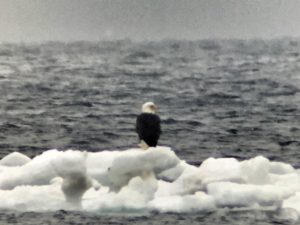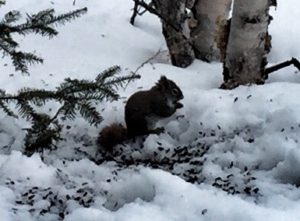
Weather –
Foggy start to the count today with light winds out of the north east and a temperature of -1C. By the afternoon most of the fog and haze had cleared out of the straits and visibility was good. No heat shimmer and wave action was minimal. The winds were variable throughout the count, always out of the north east. For the most part it was quite comfortable though with temps at 2.2C by the afternoon. The barometer rose slightly through the day.
Waterbird Notes –
The waterbirds were on the move today despite a slow start. This may be partly due to the fact that the visibility was hampered in the early morning at 2km in either direction. By the afternoon the fog and haze had blown out of the straits and with the aid of some freighter traffic to bump the birds some decent detections were made. The first freighter of the morning east bound stirred up a large group of WWSC. After getting a good handle on these birds numbers it was time to watch the bow of the boat and figure out where the LTDU were hiding. 310 was the approximate high count. I am starting to see a steady increase of COME as well. The RBME didn’t lead todays flight with only 139 individuals counted. 2 DCCO made tried to make their way through without being counted, rounding the Gros Cap vicinity east bound. Their crooked necks helped clench the first detection of the year and I know many area birders will be happy these majestic birds have returned! Bruce Seeger put me on two TRUS winging their way north. These birds looked like they hardly had to work to cross the straits.
Non- waterbird Notes –
Stellar day for observing raptors crossing the straits. With one of the regular hawk counters Bruce Seeger contributing today and a nice high stratus cloud backdrop the detections were awesome. The wind was out of the north east and the birds favored a McGulpin Point crossing flight path which was first blazed by an adult male NOHA. This bird crossed low, right on the water. Next up were a few RTHA, followed closely after by a couple RLHA. During this action a lone GOEA tried to slip by on another well worn route to the east and coming close to the northern end of the bridge. A couple BAEA followed this route shortly after. A few small groups of SACR crossed mixed in with the raptor flight preferring the buteo flight line. TUVU were crossing too, but Bruce and I were having more fun sorting out the more exciting birds and as such mostly detected them kettling over the McDonald’s area. By days end we were up 30 species with 3 other taxa which is a new record for the spring count!

Wildlife-
Little red squirrel is back. So far he isn’t barking orders so I am hoping we may get along.
Freighters-
Unidentified ghost ship crossing the straits east bound at 6:20. That one was cool as it looked like a floating city all lit up in the fog. John J Boland west bound at 8:06. Edwin H Gott at 11:06 east bound. The Gott helped the waterbird counters put some serious numbers up on the board for the day! Algoma Transport 11:15 west bound.
Visitors –
Mr. Ed Pike was down early today to make sure I hadn’t missed any DCCO! Bruce Seeger joined us shortly thereafter. Bruce stayed until the end of the count and he helped put me onto most of the raptor detections for the day and several other waterbirds I would have missed including the swans. As things begin to warm up anyone is welcome to help spot birds and it definitely helps put up some numbers for the count. Bruce used to be a serious waterfowl hunter so he knows were to look for birds on the vast horizon of the lake. Currently the road down is passable by all wheel drive vehicles with moderate clearance and four wheel drive vehicles. That may change after the next storm arriving this Saturday evening through Sunday though so I will keep everyone posted. This weekend doesn’t look like great weather for observing waterbirds in the straits.
As I was leaving the count with Bruce, Joe Haas of the DEQ stopped by to check on our waterbirds and shoreline in the McGulpin Point area. Joe was very informative about the dielectric fluid that was released into the straits nearly two weeks ago. He actually had samples of the pumped substance that was recovered from the power lines. It is the color of canola oil, but has a smell of gasoline. He explained that it would be difficult to detect at a distance as it isn’t going to give off a rainbow sheen like gasoline or oil that is on top of the water. It basically would look like canola oil floating on top of the water, mostly clear. It may have an odor though, like a stain you would use on your deck. In reality where in the straits this substance might have gone is still to be determined. Although the current on the surface is going one way, there may be two more different currents in layers under the surface moving in different directions. He explained that the currents in the straits are mostly linked to barometric pressure changes, which I am interested to see if I can start noticing while taking my weather readings. Joe explained from my vantage at McGulpin the most likely way of seeing this substance may be later in the spring when the shore ice has melted. Since I am near shore that is where I would have a chance to see it and that is where some of it may end up. He welcomed any and all observations regarding the dielectric fluid and also shared some of his experiences collecting waterbirds in distress from other oil spill responses he has worked on in the past. Two weeks into this situation I am happy to report that I now know what to look for and who to relay information to should I see anything. I did want to share that on the 11th I noticed during the close of the count at 2:30PM an intense odor wafting on the wind from somewhere to the east of me. I honestly couldn’t say it was the smell of the dielectric fluid as that smells more like gas or turpentine. This smell had more of natural gas smell but it was strong. I also got a severe headache later in the evening that was quick in onset which is not common for me. I forgot about it, chalking it up to dehydration. However, after talking with Lynn Fraze today she mentioned to me she had a horrible headache and nausea upon returning home from the count on the 11th. She too was down for most of the day on the 11th. I will continue to monitor this situation and hope that it wasn’t anything related to inhaling hazardous chemicals.
Total observer hours – 8.0
Next days forecast –
Snow likely, mainly before 8am. Cloudy, with a high near 29. Blustery, with a northeast wind 20 to 25 mph, with gusts as high as 35 mph. Chance of precipitation is 60%. New snow accumulation of less than a half inch possible.
Todays tally is posted on eBird here.
